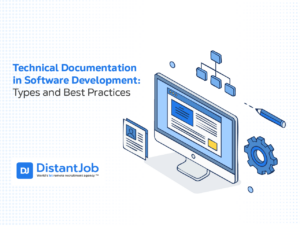Do you have to off-board a remote employee?
Oh! That ghastly feeling!
Whether you’ve just learned that your prized remote employee is leaving, or you’ve decided it’s time to part ways, the end of an employment relationship can be challenging. Proper remote offboarding is as crucial as the onboarding process and must be handled with care to avoid disruptions.
Having a clear-cut offboarding process in place that’ll help your company get back to the essential tasks with minimal disorder is vital. Inadequate offboarding can lead to data breaches and loss of intellectual property, heightening the risks of legal and financial repercussions.
As an HR expert, you are responsible for ensuring that all company assets are returned, access to systems is revoked, and confidentiality is upheld. These measures can minimize potential issues and allow you to focus on finding a suitable replacement.
In this article, we’ll share essential tips on refining your company’s exit process for remote employees. These tips have been successful in our company, which has been fully remote for more than a decade.
Here’s how you can offboard a remote worker smoothly:
- Good relationship matters
- Implementation of a knowledge transfer process
- Exit interview
- The company’s data security
- Retrieve Equipment
- Exit paperwork
1. Maintain a Good Relationship with Your Parting Remote Employee
If you prioritize the relationship, then the rest of the process will be smooth sailing, peaceful, and agreeable.
At DistantJob, we’re experts in IT recruitment. However, when it comes to virtual IT offboarding, we’ve learned that one of the most important things is to try to end the professional relationship in the best way possible.
These are some of the main reasons why having a good relationship with your departing remote employee is crucial:
- Like it or not, all employees are your brand ambassadors.
- Your company will decidedly have some networking overlap with your employee. A positive word from an ex-employee often has more weight than any marketing.
- Lastly, a valued employee may rejoin the company. You should make room for that to happen.
2. Implement A Progressive Knowledge Transfer Process
Arguably, the worst part about a valued employee leaving is the uncertainty of whether another person can carry out those tasks with the same degree of competency.
One great advantage of having remote employees is that almost all the work transpires on a remote management platform. This increases the chances of having trackable work and proper documentation than if the employee worked onsite.
That said, you should do regular “knowledge transfers” so that you don’t panic in emergencies.
Regular one-on-one meetings are excellent opportunities to ask employees more nuanced questions about their work processes, approach to a project, creative ideas. As well as get a complete sense of their current tasks.
Systematic work shadowing is another way to keep tabs on employees’ work. And have other members of the team ready to take on their roles if need be.
Most importantly, proper documentation that follows companywide standards is easy for other employees to understand. In the offboarding process, you should ask your parting employee to leave all the necessary documentation about their tasks. This means that this person’s main role and responsibilities are explained clearly, so when the next person comes, it is easier for them to understand how to manage those new tasks.
If possible, involve the parting employee in the interview process for their replacement. Better still, ask them to train the new hire.
3. Conduct A Meaningful Exit Interview
Whether they’re leaving of their own accord or you’ve let them go, a video conversation with your parting remote employee is essential.
Keep your main goal of maintaining a good relationship with them in mind. Don’t hold a grudge if someone is quitting. Instead, find out what prompted them to consider leaving.
Take this as an opportunity to gain more insight into the role itself, how working remotely affected it, which projects they enjoyed working on, etc.
Besides providing them with useful feedback, ask them about how working in your company was for them. They can also give you feedback regarding how the company experience is, and this can help you improve certain aspects – These answers could be a springboard for your company to make positive changes.
If there are unresolved issues, it’s better to address them head-on than shoving them under the rug. Reiterate their contributions to your company to make the departure amicable.
4. Ensure Data Security
A well-functioning remote work environment demands openly sharing information that’ll enable developers to do their best work.
But once that relationship comes to an end, you have to take measures to secure your company information.
When working with remote management tools, for instance, make sure work data can’t be transferred out of the system without notification. Or file sharing apps don’t share to personal accounts.
Other than that, recover your digital assets from the employee, including passwords, key codes, and access to virtual security rooms, and change them when they leave.
Let them know when their access will be terminated so that it doesn’t come as a surprise. And notify the IT admin to start the due procedures.
Lastly, update your lists, so they’re not invited to the next meeting or keep receiving company emails.
5. Retrieve Equipment
Managing the retrieval of equipment from remote employees is an important step in the offboarding process. It involves several detailed actions to ensure all company property is returned safely and promptly. As an HR professional, you should make the retrieving process as easy as possible for employees to follow. Start with:
- Clear Communication: Keep instructions simple and direct. Clearly outline each step the employee needs to take to return their equipment.
- Prepaid Return Kits: Send the employee a box with the necessary packing materials and a prepaid shipping label. This minimizes their effort and ensures equipment is returned safely.
- Drop-Off Options: Allow employees to drop off their equipment at a local courier service, charging the shipping to the company account. This gives them the flexibility to return items at their convenience.
- IT Assistance: IT should step in to handle the technical aspects, such as ensuring that all data is securely wiped and that the equipment is functionally assessed upon return.
- Remote Wipe: For less critical equipment, consider just wiping the data remotely and letting the employee keep the device, eliminating the need for physical returns.
- Reimbursement for Returns: If employees are responsible for sending back equipment, provide clear instructions on how to claim reimbursements for any associated costs, ensuring they’re not out of pocket.
6. Prepare Your remote team member’s Exit Paperwork
Just like onboarding, the exit process comes with its own set of paperwork. The procedure for a remote employee is no different than that for an onsite employee—except all the forms are digital.
Although there might be a few company-specific items, some common points on the exit paperwork checklist should include:
- Get updated contact information – because you’re going to forward documents to that email address.
- Reiterate the benefits they’re eligible to receive, such as unused vacation days and bonuses, and when they’ll do so.
- Clarify the legal stuff and remind them of any agreements they may have signed, such as non-compete clauses, confidentiality documents, and non-disclosure agreements.
- Ask them what they want to do with their 401 (k) and take the necessary actions, such as rolling it over to the next employer.
- Apprise them of some of the other documents they’ll receive from you in due time, such as the W2 form.
- Let them know when they’ll get their final salary.
- Make sure you’re in COBRA compliance – and the employee’s insurance benefits will be extended for a period, and clarify when those will come to an end.
Uuff! That’s a lot, isn’t it? Can’t be helped – it’s another burden a small business owner has to bear. Or do you???
No, you don’t. DistantJob can deal with all that for you. When you use our services to find a remote developer, we’ll do all the paperwork for you. And find you a replacement so that you can go back to running your business.
Not only that, we put in assiduous effort to find the right developer—someone who is right for the job and will fit with your company culture. Result? Our remote developers don’t up and quit easily, and they give you even fewer reasons to let them go. If you’re ready for a long-term, full-time, remote developer, you ought to call us now.





